These TS 8th Class Physical Science Important Questions 11th Lesson Stars and the Solar System will help the students to improve their time and approach.
TS 8th Class Physical Science Important Questions 11th Lesson Stars and the Solar System
Question 1.
Why is moonlight cool and soothing?
Answer:
- The surface of the moon is covered with dark dust.
- The dark dust absorbs most of the sunlight falling on it.
- Only 7% of the sunlight falling on the moon’s surface is reflected back.
- This reflected light reaches Earth as cool, soothing and pleasant moonlight.
Question 2.
What is a Lunar eclipse? When does It occur?
Answer:
Sometimes on full moon day, the moon loses its tightness for some time. It appears covered partially or lulav. This is called. Lunar eclipse.
Reason: A lunar eclipse occurs when the shadow of the earth falls on the moon It takes place only on full moon day.
Question 3.
What are the types of Lunar eclipses? Explain.
Answer:
Lunar eclipse can occur in three types:
- Total Lunar eclipse: It occurs when the earth’s shadow (umbra) obscures all of the moon’s visible surface.
- Partial Lunar eclipse: It can be observed only when part of the moon’s visible surface is obscured by the earth’s shadow.
- Penumbral Lunar eclipse: It happens when the moon travels through the partially shaded outer region of the shadow cast by the earth (earth’s penumbra).
Question 4.
Why does a Lunar eclipse occur only on a full moon day?
Answer:
A Lunar eclipse occurs when the shadow of the earth falls on the moon. It occurs only on full moon nights.
Question 5.
Why a solar eclipse occurs only on a new moon day?
Answer:
A solar eclipse occurs when the shadow of the moon falls on the earth. It occurs only on new moon das.
Question 6.
Why is that a solar eclipse does not occur on every new moon day and a lunar eclipse does not occur on every full moon day?
Answer:
- The orbit of the moon round the Earth is elliptical and a little inclined to the plane of the sun and the earth.
- This is the reason that solar and lunar eclipses occur only on some new moon days and full moon nights and not every month.
Question 7.
From the earth, we are able to see only one face of the moon. Why?
Answer:
1. The moon shows views of motions in the space. They are:
- it spins (rotates) upon its axis and
- it revolves around the earth.
2. From the earth, we find that the moon revolves around the earth in 29½ days and it takes the same time (29½ days) to rotate upon its own axis. The result is that from the Earth, we are able to see only one face of the moon. The other side of the moon always remains away from the Earth.
Question 8.
What are the types of solar eclipse? Explain.
Answer:
Solar eclipse can take place in 4 different ways.
- Total solar eclipse: It occurs when the moon completely covers the sun, as seen from Earth.
- Partial solar eclipse: It is observed when the partially shaded outer region of the shadow cast by the moon (Lunar penumbra) touches the earth.
- Annular eclipse: It occurs when the moon appears smaller than the sun as it passes centrally across the solar disc and a bright ring (annulus) of sunlight remains visible during eclipse.
- Hybrid eclipses: These are a rare form of solar eclipse, which changes from an annular eclipse to a total solar eclipse along its path.
Question 9.
What are constellations?
Answer:
- Stars usually appear in groups.
- Members of these groups when viewed together, form different shapes.
- These groups of stars, resembling some animals and human beings are called, constellations. Ex: Great Bear, Orion etc.
Question 10.
What should you do If you wish to study the movement of stars across the sky?
Answer:
If we wish to study the movement of stars across the sky and trace their paths. We must observe the polar star, the Saptharishi constellation and the Sharmistha constellation.
Question 11.
Why do stars appear to move from east to west?
Answer:
- A star which rises in the east in the evening sets in the west in the early morning.
- Thus, the stars appear to move from east to west, because the earth rotates from west to east.
Question 12.
Why does the sun appear to rise in the east and set in the west?
Answer:
It is because the earth rotates from west to east on its axis.
Question 13.
Why did our ancient people devise constellations?
Answer:
They devised constellations to be able to recognise stars in the sky.
Question 14.
Name some of the constellations visible from Andhra Pradesh In the night sky.
Answer:
- Saptharishi
- Sharmistha.
- Orin (Hunter)
- Leo (Simha Rashi)
The shapes of these constellations remain the same but they appear to move in the sky from east to west.
Question 15.
Name the planets In the order of distance from the sun.
Answer:
- Mercury,
- Venus,
- Earth,
- Mars,
- Jupiter,
- Saturn,
- Uranus and
- Neptune.

Question 16.
What is the main source of heat and light for the planets of our solar system?
Answer:
Sun is the main source of heat and light for all planets in our solar system.
Question 17.
State the physical conditions of different planets.
Answer:
Physical conditions of different planets.
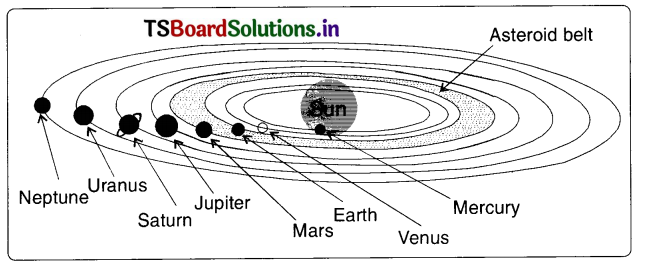
i. Mercury:
- Mercury is the smallest planet.
- It is nearest to the sun.
- It is the hottest planet and perhaps without any atmosphere.
- It is not seen, since most of the time it remains in the glare of the sun.
- However, it can be observed before sunrise or just after sunset, near the horizon, for a very short time.
- So it is called a morning star and an evening star’, though it is not a star.
ii. Venus:
- Venus is the brightest planet in the night sky.
- It is in between the planets Mercury and earth.
- It is nearest planet to the Earth.
- It appears as ‘morning star before sun-rise and as ‘evening star’ after sunset.
- In the solar family, Venus and Uranus only rotate from east to west on their axes (All other planets rotate from west to east on their axis).
iii. Earth:
- Earth is the third planet from the sun.
- It is the only known planet with life on it.
- \(\frac{3}{4^{\text {th }}}\) of earth is covered with water. Only \( \frac{1}{4^{\text {th }}}\) is land.
- It reflects sunlight falling upon it as blue light’ and hence is also called a ‘blue planet’.
- It is surrounded by a blanket of ozone layer.
- Atmosphere. comprised of many gases is present on it.
- On an average, its temperature varies from 15°C to 55°C
iv. Mars:
- Mars is the fourth planet from the sun and next to the Earth.
- It is smaller than the Earth.
- It appears slight reddish. So it is also called a red star’.
- It has two small natural satellites.
- The temperature on mars is too low (cold). So no life can exist.
- It has a very thin atmosphere with little water and oxygen. The above 4 planets are rocky in structure. So they are called the ‘Terrestrial planets, They are very near the sun So they are called also, ‘Inner planets’.
v. Jupiter:
- Jupiter is the largest planet of the solar system. 1300 earths can be placed inside this giant planet.
- But the mass of Jupiter is only \(\frac{3}{8^{\text {th }}}\) of our earth.
- It is surrounded with an atmosphere of hydrogen. So it appears as the brightest planet.
- It rotates rapidly on its axis, hut slowly goes around the sun.
- It has 29 or even more moons.
vi. Saturn:
- It is one of the giant planets in the solar system.
- It is slightly smaller than Jupiter, in size.
- It appears yellowish in colour.
- It is more gaseous and is less dense than water (It can float on water).
- It has nearly 30 moons.
vii. Uranus:
- It is the third biggest planet in the solar system.
- Like Venus, Uranus rotates from east to west.
- It rotates on its highly tilted axis. As a result, it appears to be rolling on its sides.
- It has a ring around it and has 22 moons.
viii. Neptune:
- It is the eighth planet from the sun.
- It has a ring around IL It has 8 satellites revolving around it.
- It takes 165 years to complete one revolution round the sun. Jupiter, Saturn, Uranus and Neptune are far away from the sun. They are called the outer planets.
Question 18.
What are ‘Asteroids’?
Answer:
- Asteroids are the minor members of the solar system.
- They are irregular lumps of rocks, some big and some small.
- They orbit around the sun in the space between the orbits of Mars and Jupiter.
Question 19.
What are comets?
Answer:
- Comets are members of our solar system.
- They revolve around the sun in extremely elliptical orbits.
- The orbit of a comet is in a different plane than the orbits of the EIGHT planets.
- A comet appears as a bright head with a long, tail. So it is also called a “Tailed star.”
- There are hundreds of comets which orbit around the sun.
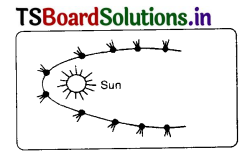
Question 20.
What are Meteoroids, Meteors and Meteorites?
Answer:
- These are all celestial bodies.
- The three are the same materials.
- A meteoroid is the rock material orbiting the sun at a high speed of 20 to 70km/s in the space.
- A meteor is a glowing hot rock material passing through the earth’s atmosphere. It is also called as ‘shooting star’, though it is not a star.
- A meteorite is the rock material from a meteoroid which has fallen upon earth.
Question 21.
What are ‘artificial satellites’? Name a few.
Answer:
- Artificial satellites are man-made.
- They are launched from the earth.
- They revolve around the earth much closer than the moon (a natural earth’s satellite)
Some Indian satellites are: Arvabhatta, ENSAT, IRS, KALPANA -1, EDUSAT, etc.
Question 22.
Who proposed the ‘hello-centric’ theory?
Answer:
- Nicholas Copernicus suggested that the sun is at the centre of the universe and all other celestial bodies revolve around the sun from west to east.
- It was assumed that the earth rotates on its axis in front of the sun.
- This model can explain the occurence of days and nights.
Question 23.
What is your local noon time?
Answer:
I performed the following activity in my place to find the local noon-time.
- selected a flat spot in an open ground such that there are no trees or buildings nearby which cast a shadow on the spot during the period of the experiment.
- A stick which isa little over a metre long is fixed vertically in the spot, such that exactly /metre of the stick is above the surface of the ground.
- A small fence is arranged around the stick to keep people away from it.
- I made the first observation of the shadow of the stick at 9 A.M. I made a mark with a nail at the point where the tip of the shadow touched the ground.
- I measured the length of this shadow.
- I made similar observations every half an hour till 4 P.M. and tabulated the readings.
- From this data, I found that in my place, the shortest shadow formed at 12.10 noon.
So in my place, the local noon time is 12.10 P.M.
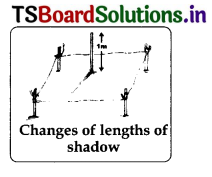
Question 24.
Where do you find moon at night
a) 2 days before Pournami,
b) 2 days after Amavasya?
Answer:
a) 2 days before Pournami: Two days before pournami, moon appears in the east during the night.
b) 2 days after Aniavasya: 2 days after Amavasya, moon appears in the west during the night.
Question 25.
Why doesn’t eclipse occur on every full moon day or on every new moon day?
Answer:
- For an eclipse to occur, positions of sun and moon are important.
- If the sun and moon reach the point of intersection of their paths at exactly the same time, edipse occurs.
- This cannot happen on every new moon and full moon day.
- That is why eclipe does not occur on every full moon day or every new moon day.
Question 26.
Where do you find the pole star?
Answer:
We can locate the Pole star (Dhruvatara) with the help of ‘Virat Saptharishl consteLlation or ‘Sharmistha constellation. Both these constellations appear in the northern part of the sky.
1. During the summertime, in the early part of the night, we can see ‘Virat Saptharishi in the northern sky. It is a northern constellation. it is also called, Ursa Major, Big Dipper or the Great Bear. There are 7 prominent stars in this constellation. It appears like a big ladle or a question mark. In this, there are two stars that form the outer side of its rectangular head.
An imaginary line is extended towards north, connecting these two stars. The pole star will be located on that extended line with a distance of about times the distance between these Pole star two stars.
The ‘Pole star is at the tail end of another constellation, the ‘Ursa Mirror’, or the ‘laghu saptharishe. (See figure)

2. Sharmistha or Cassiopeia is also in the northern sky. It is visible during winter in the early part of the night. ¡t looks like a distorted letter ‘M’ or ‘W’. The pole star will he located on a line extended from the middle of the ‘M’.
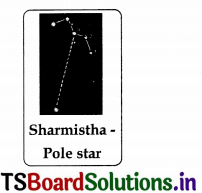
Question 27.
What is the difference that you find between Polestar and other stars?
Answer:
Differences between pole star and other stars.
| Pole star | Other stars |
| 1. The pole star does not move at all | 1. Other stars drift from east to west. |
| 2. All constellations appear to revolve around the Pole star, which remains stationary. | 2. This is not so with the other stars. |
| 3. The pole star is directly above the north pole on the axis of rotation of the earth. | 3. This is not so in case of other stars. They are present in different places. |
| 4. The pole star is not a very bright star. | 4. There are many stars far brighter than the pole star. |
| 5. Pole star is not visible from the southern hemisphere. | 5. This is not true in case of many other stars. |
Question 28.
Name some constellations.
Answer:
- The stars forming a group that has a recognisable shape is called a ‘constellation.’
- The shapes of constellations resemble oh,ects familiar to those people.
- early 8 constellations around the earth have been given different names according to the imagination-v figure thes’ form.
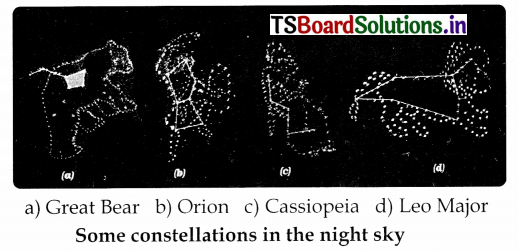
- Some better known constellations visible to the naked eye are: a) Ursa Major (Virat Saptharishi) b) Orion (or Hunter) c) Cassiopeia (M-shaped) (Sharmistha) d) Leo Major (Lion)
Question 29.
Look at the table- 2 T.B. PMo. 165 and name the smallest and the biggest planets In our solar system.
Answer:
When compared to the diameter of the Earth. Mercury is the smallest planet and Jupiter is the largest planet
(Note: Earth’s diameter 12756 km is considered as I unit.)
Diameter of Mercury = 0.3S units (12756 0.34 km)
Diameter of Jupiter = 1119 units (12756 11.19 km)
Question 30.
Do the stars moving? If so why?
Answer:
Yes, The stars appear to move from east to west. This is because the earth rotates from west to east. A star which rises in the east in the evening sets in the west in the early morning.
Activity to show that the stars revolve around the polestar. The polestar does not appear to move, since it is situated in the direction of the earth’s axis of rotation.
- Take a 20cm x 20cm square sheet of paper and make a 1 cm diameter hole in its centre.
- Mark a cross (x) on one side of the sheet of paper as shown in figure.
- Hold the sect in front of your eves with the x mark at the bottom
- Look at the polestar through the hole of the x paper.
- Holding the paper steadily, write G for Great Bear and ‘C’ for Cassiopeia on the paper in the directions in which you see each of the constellations.
- Simultaneously mark the time of observation in both the case.
- Choose a nearby tree as a reference point and draw its picture on the sheet. clearly indicating its location.
- Repeat your observations at one-hour intervals. Note G and C in the directions
of these stars noting the time also. - Repeat this activity at least four times.
- From this activity, ‘you can know that the stars do not remain the constant positions. They revolve around the pole star.
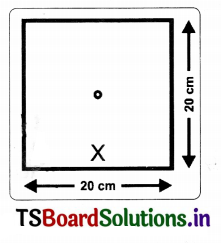
Question 31.
Why is Venus the brightest planet?
Answer:
Venus is the brightest planet in the night sky. It is an inner planet. It is very near the sun. It is rocky in structure. It appears as a morning and night.!. It is covered by a thick blanket of clouds made up of H2, O2, N2 and CO2. This cloud reflects 80% of the sunlight falling on it. So Venus appears bright.
Question 32.
Are you curious about going to the moon? Why?
Answer:
Since past, moon has become a fascinating object for poets and storytellers. When I was a child, my mother used to glorify the moon, while feeding me, She used to tell about an old woman on the moon, sitting and spinning all the time.
Moonlight is a cool light. So everybody likes the moon including me. Naturally, I developed a curiosity to visit moon and judge the truth in those tales about moon.
Question 33.
While observing the shadow of a stick from morning to evening, some questions arose in Ramya’s mind. What may be those questions?
Answer:
The possible questions that raise in Ramva’s mind may be as follow.
- Why should the spot selected be as flat as possible?
- Why should exactly one metre of the stick remain above the surface of the ground?
- How is the length of the shadow, related to the rotation of earth?
- Why does the length of the shadow change?
- Do we get the same results in Dakshinayanam and in Uttarayanam?
- Will the shadow of the stick be the same in all the days at noon?
Question 34.
In which direction (towards north or south) Is the sun moving day by day when you read this lesson?
Answer:
1. When the sun looks like travelling towards the south of the sky, it is called the Dakshinavanam.
2. ‘When the sun looks like travelling towards north of the sky, it is called Uttarayanam.
(Note:Dakshinavanam: From 16th July 20th to 14th January 2017.
Uttarayanam: From 15th January 2017 to 13th July 2017.
The date and month are not the same every ‘ear. It changes.)
Diagrams
1.

2.

3.
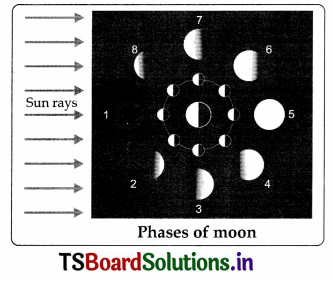
4.
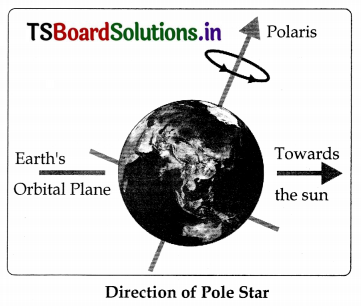
5.

6.
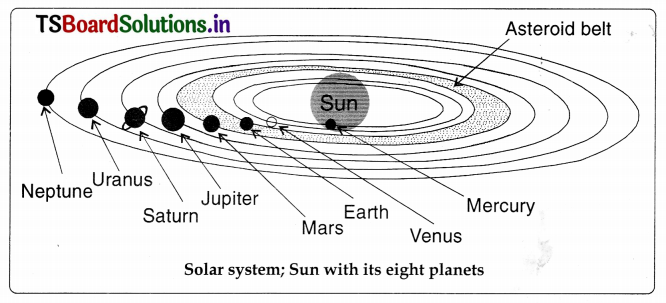
Multiple Choice Questions
Question 1.
These are a part of the solar system ( )
A) Planets
B) Satellites
C) Meteors
D) All the above
Answer:
D) All the above
Question 2.
The nearest star from us is ( )
A) Sun
B) Pole star
C) Mercury
D) Moon
Answer:
A) Sun
Question 3.
The star nearest to the sun is ( )
A) Sukra
B) Buciha
C) Earth
D) Shani
Answer:
C) Earth
Question 4.
The planet that rotates from east to west on its axis ( )
A) Sukra (Venus)
B) Budha (Mercury)
C) Yama (Pluto)
D) None of them
Answer:
A) Sukra (Venus)
Question 5.
This is not a member of the solar system ( )
A) An asteroid
B) A satellite
C) A constellation
D) A comet
Answer:
B) A satellite
Question 6.
Which of the following is not a planet of the sun? ( )
A) Sirius
B) Mercury
C) Saturn
D) Earth
Answer:
A) Sirius
Question 7.
Phases of the moon occur because ( )
A) We can see only that part of the moon which reflects light towards us.
B) Our distance from the sun keeps changing.
C) The shadow of the Earth covers only a part of the moon’s surface.
D) The thickness of the moon’s atmosphere is constant.
Answer:
A) We can see only that part of the moon which reflects light towards us.
Question 8.
The planet which is farthest from the sun is ( )
A) Mars
B) Jupiter
C) Neptune
D) Venus
Answer:
C) Neptune
Question 9.
The planet that appears reddish in colour is ( )
A) Jupiter
B) Mars
C) Pluto
D) Saturn
Answer:
B) Mars
Question 10.
A group of stars that appear to form a pattern in the sky is known as ( )
A) Satellite
B) Meteors
C) Constellation
D) Dhruva Tara
Answer:
C) Constellation
Question 11.
A celestial body that revolves around a planet is known as ( )
A) Meteor
B) Satellite
C) Meloroide
D) None
Answer:
B) Satellite
Question 12.
Asteroids are found between the orbits of ……………. and ………………. . ( )
A) Mars, Jupiter
B) Jupiter, Saturn
C) Saturn, Uranus
D) Uranus, Neptune
Answer:
A) Mars, Jupiter
Question 13.
This is not a member of the solar system ( )
A) Earth
B) Pluto
C) Pole star
D) Moon
Answer:
C) Pole star
Question 14.
The smallest planet of the solar system ( )
A) Mercury
B) Saturn
C) Venus
D) Earth
Answer:
A) Mercury
Question 15.
An artificial satellite ( )
A) Moon
B) INSAT
C) Meteor
D) Titan
Answer:
A) Moon
Question 16.
The number of planets in the solar system ( )
A) Nine
B) Eight
C) Ten
D) Seven
Answer:
B) Eight
Question 17.
The largest planet of the solar system is ( )
A) Saturn
B) Mars
C) Jupiter
D) Orion
Answer:
C) Jupiter
Question 18.
The next nearest star to the Earth after the sun is ( )
A) Alpha Centauri
B) Orion
C) Cassioperia
D) Saturn
Answer:
A) Alpha Centauri
Question 19.
The planet that rotates from east to west ( )
A) Saturn
B) Uranus
C) Venus
D) Both (B) and (C)
Answer:
D) Both (B) and (C)
Question 20.
Pole star appears near the ( )
A) Southern horizon
B) Northern horizon
C) Anywhere in the sky
D) Nowhere in the sky
Answer:
B) Northern horizon